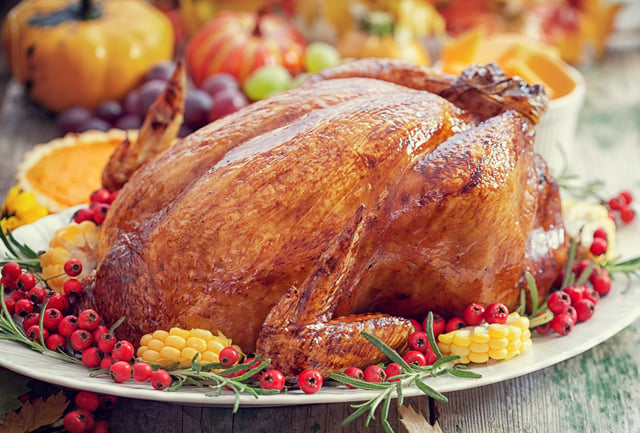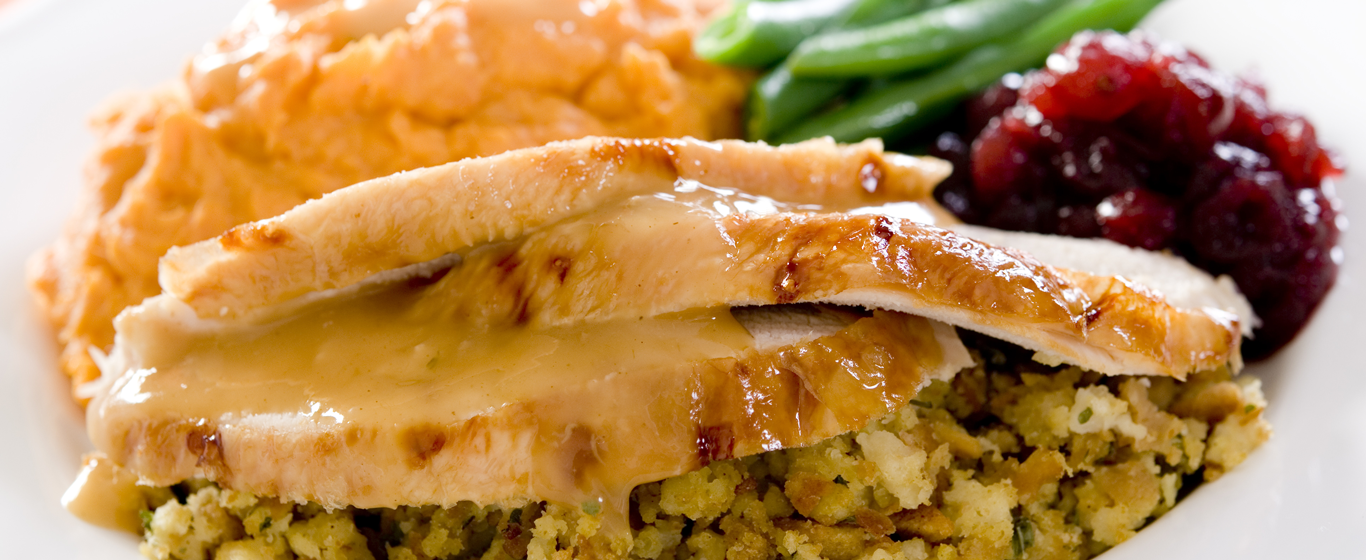
Turkey
The Thanksgiving meal wouldn’t be the same without its star . . . the turkey! The traditional protein is something of lore with the roasting hacks, brine vs baste decision, stuffed vs dressed debate, its tendency to cause napping, and even a famous turkey talk hotline.
Consider these Turkey Day staple facts:
- It’s ready to pop! Knowing when the turkey is done generally relies on a simple thermometer that pops up when the internal temperature of the turkey reaches 185 degrees Fahrenheit. But what keeps the thermometer in position until then? A drop of solder keeps the spring-loaded plunger down until the turkey reaches the designated temperature, at which point the solder melts and the signature red plunger pops up. (PS: Not to worry, the metal is covered by the plastic, keeping the meat safe to eat.)
- It’s as good as gold. There can be a lot of pressure to cook the perfect turkey. It is, after all, the centerpiece of the meal. Home cooks might spend days researching and preparing prior to the big day. There’s thawing, brining, stuffing, seasoning, and roasting (or frying). And when the golden bird is brought to the table, attracting the oohs and aahs, we have the Maillard reaction to thank. The Maillard reaction is a chemical reaction between amino acids and reducing sugars in food when exposed to heat. The reaction produces browning and a distinctive aroma and flavor.
- Don’t blame the bird for your drowsiness. Turkey contains an essential amino acid, tryptophan, that has long been blamed for those after-dinner naps. But grandma might not have had the facts quite right. You see, tryptophan is used by the body to produce serotonin, a neurotransmitter that affects your mood, sleep, and behavior. It is also a precursor to melatonin, a hormone associated with sleep. But the ingestion of an increased amount of tryptophan from excess turkey does not solely or inherently boost serotonin or melatonin production and thus isn’t the cause of our post-meal tiredness. However, the introduction of extra carbs such as mashed potatoes, dinner rolls, and dessert causes our bodies to secrete an increased amount of insulin, which is a hormone related to the intake of glucose and most amino acids. This release triggers a series of internal reactions, which reduces the other competing amino acids (you know, from everything else you consumed besides the turkey), allowing the tryptophan to increase the serotonin synthesis.
- But then again, scientists have also proposed our need for sleep after the meal could just be from stuffing ourselves and then working to digest the abundance of food.

Pumpkin Pie
Polishing off your Thanksgiving meal generally means a slice of pumpkin pie (or two). So, what’s the science behind one of fall’s favorites? Well. . . .- The filling: Pumpkin pie filling is more custard than a traditional fruit filling. It’s pumpkin puree, eggs, sugar, spices, and some cream. How do you mix it all up to achieve the perfect texture? It’s all about the eggs, the fat, and the cooking temperature. As the pie cooks, the egg proteins gel together to create the custardy structure, and as it continues to cook, the proteins shrink. Cooking it at a higher temperature for a brief period and then at a lower temperature for the remaining time keeps the pumpkin mixture from shrinking too much and creating a broken, grainy texture. Plus, the fat from egg yolks and cream assist in helping with the silky appearance and consistency.
- The crust: A golden, buttery crust is essential to a quality pie. To produce such a crust you need a good balance of flour, water, and cold fat (i.e., butter!). The water mixed with flour creates gluten; too much water will make your crust tough; too little will give you a weak, soggy crust. The cold fat is cut into the flour and creates coated pockets of fat when rolled out – these pockets turn into flaky layers. Many chefs also recommend prebaking your pie crust prior to filling.

Gratitude
Saying “thank you” is more than just being polite. Gratitude is scientifically proven to positively affect your physical, emotional, and social health. Forbes and the Huffington Post have both published articles citing many of the benefits. For example, being grateful can lead to:- Sleeping longer and better. A few more zzzz’s are sure to make anyone feel better!
- Fewer aches and pains. Focusing on the good makes feeling good possible (lower blood pressure, more activity, and more energy). And, that is something to truly appreciate!
- More happiness and less depression. Negativity creates toxic emotions that are physiologically harmful to a person. Gratitude helps you reduce those emotions. That’s reason enough to smile more!
- Higher self-esteem. There’s no time to compare yourself to others or to be resentful of the things you don’t have that someone else does (money, status, time, physique, talent, relationships, and so forth) when you’re focused on the positives in your life. Plus, you’re also better able to genuinely celebrate others’ successes.
- New and better relationships. Your relationships have an enormous impact on happiness. Essentially, it’s all about proximity and ratios. More positive than negative interactions with those nearest and dearest to you lead to better sustained, fruitful relationships and more happiness. And, frankly, happier people are more approachable and better positioned to acquire new acquaintances and cultivate friendships.
Looks like a little gratitude goes a long way.
Our Pitsco family is enormously grateful for Y-O-U. We value your daily contributions to the lives of the young citizens and students across the world. We hope this season brings you bountiful blessings including time, food, and memories to share with your favorite people.
Happy Thanksgiving from all of us!
Extra Helping of STEM
Need a few fun STEM activity ideas to engage your family and friends in between the parade, meals, and football games? Check out this roundup!
Article Sources:- Does Turkey Make You Sleepy?
- Seven courses of science for Thanksgiving
- The Science of Roasting Turkey: Nathan Myhrvold Explains the Maillard Reaction
- The Science Behind Baking Your Perfect Pie (Happy Pi Day)
- How to make the perfect pie crust, according to science
- The Neuroscience of Why Gratitude Makes Us Healthier
- 7 Scientifically Proven Benefits Of Gratitude That Will Motivate You To Give Thanks Year-Round
- Understanding the Science of Thanksgiving
TOPICS: BEYOND THE CLASSROOM, IDEAS & INSPIRATION, Culture, STEM, Resources



